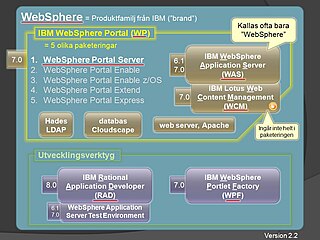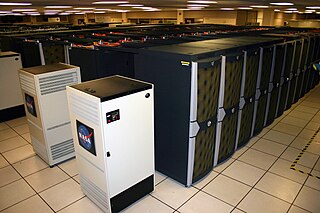In telecommunication, provisioning involves the process of preparing and equipping a network to allow it to provide new services to its users. In National Security/Emergency Preparedness telecommunications services, "provisioning" equates to "initiation" and includes altering the state of an existing priority service or capability.
Grid computing is the use of widely distributed computer resources to reach a common goal. A computing grid can be thought of as a distributed system with non-interactive workloads that involve many files. Grid computing is distinguished from conventional high-performance computing systems such as cluster computing in that grid computers have each node set to perform a different task/application. Grid computers also tend to be more heterogeneous and geographically dispersed than cluster computers. Although a single grid can be dedicated to a particular application, commonly a grid is used for a variety of purposes. Grids are often constructed with general-purpose grid middleware software libraries. Grid sizes can be quite large.

IBM WebSphere refers to a brand of proprietary computer software products in the genre of enterprise software known as "application and integration middleware". These software products are used by end-users to create and integrate applications with other applications. IBM WebSphere has been available to the general market since 1998.
The D-Grid Initiative was a government project to fund computer infrastructure for education and research (e-Science) in Germany. It uses the term grid computing. D-Grid started September 1, 2005 with six community projects and an integration project (DGI) as well as several partner projects.
Metacomputing is all computing and computing-oriented activity which involves computing knowledge utilized for the research, development and application of different types of computing. It may also deal with numerous types of computing applications, such as: industry, business, management and human-related management. New emerging fields of metacomputing focus on the methodological and technological aspects of the development of large computer networks/grids, such as the Internet, intranet and other territorially distributed computer networks for special purposes.

Volunteer computing is a type of distributed computing in which people donate their computers' unused resources to a research-oriented project, and sometimes in exchange for credit points. The fundamental idea behind it is that a modern desktop computer is sufficiently powerful to perform billions of operations a second, but for most users only between 10–15% of its capacity is used. Common tasks such as word processing or web browsing leave the computer mostly idle.
The National E-Infrastructure Service (NES), formerly the National Grid Service, was an organisation for UK academics and researchers from 2004 through 2011. It was funded by two governmental bodies, Engineering and Physical Sciences Research Council (EPSRC) and the Joint Information Systems Committee (JISC).
SynfiniWay was middleware with which a virtualised IT framework can be created that provides a uniform and global view of resources within a department, a company, or a company with its suppliers. This virtualised IT framework is service-oriented, meaning that applications are run as services, which are a system-independent view of applications. Several applications can be linked in a workflow, and data exchange between the applications participating in the workflow is implicitly managed by the IT framework. SynfiniWay is platform-independent, allowing almost any distributed heterogeneous platform to be linked into its virtualised IT framework.

The Grid and Cloud User Support Environment (gUSE), also known as WS-PGRADE /gUSE, is an open source science gateway framework that enables users to access grid and cloud infrastructures. gUSE is developed by the Laboratory of Parallel and Distributed Systems (LPDS) at Institute for Computer Science and Control (SZTAKI) of the Hungarian Academy of Sciences.

Péter Kacsuk is a Hungarian computer scientist at MTA-SZTAKI, Budapest, Hungary.

Róbert Lovas is a Hungarian computer scientist at SZTAKI, Budapest, Hungary.
A scientific workflow system is a specialized form of a workflow management system designed specifically to compose and execute a series of computational or data manipulation steps, or workflow, in a scientific application.
The SHIWA project within grid computing was a project led by the LPDS of MTA Computer and Automation Research Institute. The project coordinator was Prof. Dr. Peter Kacsuk. It started on the 1st of July 2010 and lasted two years. SHIWA was supported by a grant from the European Commission's FP7 INFRASTRUCTURES-2010-2 call under grant agreement n°261585.

DIET is a software for grid-computing. As middleware, DIET sits between the operating system and the application software. DIET was created in 2000. It was designed for high-performance computing. It is currently developed by INRIA, École Normale Supérieure de Lyon, CNRS, Claude Bernard University Lyon 1, SysFera. It is open-source software released under the CeCILL license.

Quasi-opportunistic supercomputing is a computational paradigm for supercomputing on a large number of geographically disperse computers. Quasi-opportunistic supercomputing aims to provide a higher quality of service than opportunistic resource sharing.
The Generic Grid-Grid (3G) Bridge is an open-source core job bridging component between different grid infrastructures. Its development started in 2008 within the CancerGrid and EDGeS projects. The aim was to create a generic bridge component that can be used in different grid interoperability scenarios. The 3G Bridge used within the EDGeS project that provides the core component of the Service Grid - Desktop Grid interoperability solution. 3G Bridge helps to connect user communities of different grid systems. For example, communities working on parameter sweep problems and using service grid infrastructures can migrate their applications to the more adequate desktop grid platform using the 3G Bridge technology, resulting in an accelerated research.
The High-performance Integrated Virtual Environment (HIVE) is a distributed computing environment used for healthcare-IT and biological research, including analysis of Next Generation Sequencing (NGS) data, preclinical, clinical and post market data, adverse events, metagenomic data, etc. Currently it is supported and continuously developed by US Food and Drug Administration, George Washington University, and by DNA-HIVE, WHISE-Global and Embleema. HIVE currently operates fully functionally within the US FDA supporting wide variety (+60) of regulatory research and regulatory review projects as well as for supporting MDEpiNet medical device postmarket registries. Academic deployments of HIVE are used for research activities and publications in NGS analytics, cancer research, microbiome research and in educational programs for students at GWU. Commercial enterprises use HIVE for oncology, microbiology, vaccine manufacturing, gene editing, healthcare-IT, harmonization of real-world data, in preclinical research and clinical studies.
Science gateways provide access to advanced resources for science and engineering researchers, educators, and students. Through streamlined, online, user-friendly interfaces, gateways combine a variety of cyberinfrastructure (CI) components in support of a community-specific set of tools, applications, and data collections.: In general, these specialized, shared resources are integrated as a Web portal, mobile app, or a suite of applications. Through science gateways, broad communities of researchers can access diverse resources which can save both time and money for themselves and their institutions. As listed below, functions and resources offered by science gateways include shared equipment and instruments, computational services, advanced software applications, collaboration capabilities, data repositories, and networks.
Michela Taufer is an Italian-American computer scientist and holds the Jack Dongarra Professorship in High Performance Computing within the Department of Electrical Engineering and Computer Science at the University of Tennessee, Knoxville. She is an ACM Distinguished Scientist and an IEEE Senior Member. In 2021, together with a team al Lawrence Livermore National Laboratory, she earned a R&D 100 Award for the Flux workload management software framework in the Software/Services category.








